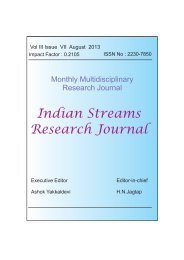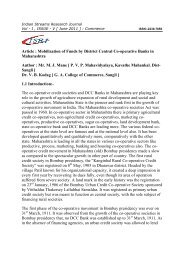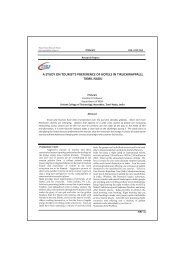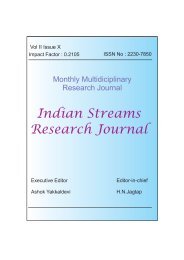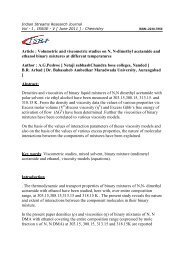the grand anicut across cauvery, tiruchirapalli: past and present ...
the grand anicut across cauvery, tiruchirapalli: past and present ...
the grand anicut across cauvery, tiruchirapalli: past and present ...
- No tags were found...
Create successful ePaper yourself
Turn your PDF publications into a flip-book with our unique Google optimized e-Paper software.
Indian Streams Research JournalVolume 3, Issue. 5, June. 2013ISSN:-2230-7850ORIGINAL ARTICLEAvailable online at www.isrj.netTHE GRAND ANICUT ACROSS CAUVERY, TIRUCHIRAPALLI:PAST AND PRESENT MODERNIZATION – REVISITEDAbstract:KEYWORDS:How wise our ancestors were to identifyThose all pervading elements five,Soil, Water, Fire, Air <strong>and</strong> SpaceTowards which now <strong>the</strong> rich nations race.Mo<strong>the</strong>r East, womb of all life, predominatesFollowed by Water sustain all that germinates.All through my care II h<strong>and</strong>les WaterOnly to find I could not master.On <strong>the</strong> lap of mo<strong>the</strong>r you were air borneTo rush Sanjeevi to save one renown,Now man has learnt to fly with easeCan he st<strong>and</strong> <strong>the</strong> Wind Power let loose!So it is with Water too,Controlled, harnessed showers benefits true;Water Shakti is too tough to harnessSo, we bow down to Thee for guidance.Desperate though confident Karikala wasWhen Cauvery suddenly changed is course.Paying obeisance to Thee we are toldHe plunged into action too bold.You Blessed him build this Anicut Gr<strong>and</strong>Across mighty Cauvery gushing water <strong>and</strong> s<strong>and</strong>,And stood here to protect it all <strong>the</strong> timeInfusing confidence in us to maintain it for a while.Cauvery, Coleroon, Ullar, Anicut, Srirangam, Tiruchirappalli, Vennar, ReservoirINTRODUCTION:A.RANJITHAssociate Professor of HistoryPachaiyappa's College , Chennai.The River Cauvery bifurcates into two branches 23 miles below <strong>the</strong> kattalai bed-regulator, <strong>and</strong>about 11 miles to <strong>the</strong> west of Tiruchirapalli. These two branches, <strong>the</strong> Nor<strong>the</strong>rn of which is called <strong>the</strong>Coleroon enclosed <strong>the</strong> Srirangam Isl<strong>and</strong>, which is about 18 miles long <strong>and</strong> 4 miles broad as its widestpoint .Srirangam is in <strong>the</strong> middle of this isl<strong>and</strong>. The river is about 7 furlong wide at <strong>the</strong> Upper Anicut, <strong>and</strong> its width<strong>the</strong>re is greater than anywhere else.Though <strong>the</strong> constriction of <strong>the</strong> Gr<strong>and</strong> Anicut prevented <strong>the</strong> wastage of <strong>the</strong> available water from <strong>the</strong>Coleroon, <strong>the</strong> bed of <strong>the</strong> Cauvery used to be gradually thinned from <strong>the</strong> point of bifurcation <strong>and</strong> that <strong>the</strong>bed of <strong>the</strong> Coleroon was being scoured, with <strong>the</strong> result that <strong>the</strong> supply of water to <strong>the</strong> Tanjore delta gradually1diminished. The extent under irrigation had gradually diminished.Title : THE GRAND ANICUT ACROSS CAUVERY, TIRUCHIRAPALLI: PAST AND PRESENT MODERNIZATION –REVISITED Source:Indian Streams Research Journal [2230-7850] A.RANJITH yr:2013 vol:3 iss:5
THE GRAND ANICUT ACROSS CAUVERY, TIRUCHIRAPALLI: PAST AND PRESENT...........Gr<strong>and</strong> Anicut Across CauveryThe Gr<strong>and</strong> Anicut is on <strong>the</strong> west of <strong>the</strong> Cauvery at <strong>the</strong> lower tip of <strong>the</strong> Srirangam Isl<strong>and</strong>. TheCauvery <strong>and</strong> <strong>the</strong> Coleroon nearly unite at this point. A channel called, Ullar, running for about threefurlongs from <strong>the</strong> Cauvery into <strong>the</strong> Coleroon, have united than much of <strong>the</strong> useful supplies in <strong>the</strong> <strong>cauvery</strong>2were flowing down <strong>the</strong> Ullar into <strong>the</strong> Coleroon in a lower bed <strong>and</strong> getting wasted into <strong>the</strong> sea.The Chola Kings constructed <strong>the</strong> Gr<strong>and</strong> Anicut <strong>across</strong> <strong>the</strong> Ullar to keep <strong>the</strong> two rivers part, longbefore any irrigation works of modem type were though of or built in o<strong>the</strong>r parts of <strong>the</strong> Country. It isbelieved to be about 1600 years old. It is 1080ft in length 40-60ft in breadth, stretching <strong>across</strong> <strong>the</strong> outlet <strong>the</strong>Ullar in a serpentine form. A portion of it was built in ogee, form, while <strong>the</strong> rest of constructed in a series ofstops, <strong>the</strong> fat of <strong>the</strong> soiled dam being protected by a rough stone apron. Only <strong>the</strong> apron wells of <strong>the</strong> oldstructure <strong>and</strong> old Hanuman Temple on <strong>the</strong> apron are now visible. Portions of <strong>the</strong> old work that still remainlie buried in <strong>the</strong> s<strong>and</strong>s of <strong>the</strong> Cauvery underneath <strong>the</strong> visible structures. On examination, it was found toconsist of a core of roughly-dressed granite, set in med, covered with cuter facing of roughly-dressed blocks3set lime water. It withstood <strong>the</strong> floods by fue care inertia of its materials.Very little of <strong>the</strong> old work remains. It has been remodeled a number of times during <strong>the</strong> last 100years <strong>and</strong> provided with s<strong>and</strong> securing <strong>and</strong> surplus sluice which dispose of <strong>the</strong> surplus water of <strong>the</strong> Cauvery<strong>and</strong> help to keep <strong>the</strong> bed of <strong>the</strong> river free from s<strong>and</strong> <strong>and</strong> modem contrivances, such as steal shutters toenable effective <strong>and</strong> timely regulator. It was raised by British Engineer in 1804 <strong>and</strong> provided with s<strong>and</strong>scouring sluice in 1830. In 1839, <strong>the</strong> existing work was used as <strong>the</strong> foundation of bridge piers <strong>and</strong> a bridgewas built over <strong>the</strong>m. In 1880, ten small scouring sluice, 3 ft. wide <strong>and</strong> 4ft high, were constructed. As <strong>the</strong>crest of <strong>the</strong> dam was a little over 9ft high, dam stones were constructed on <strong>the</strong> top of <strong>the</strong> dam project in 2 ½ft. above <strong>the</strong> crest. As <strong>the</strong> effective length of <strong>the</strong> dam, with <strong>the</strong> construction of bridge piers <strong>and</strong> <strong>the</strong> damstones, was reduces to 735ft. <strong>the</strong> stone were removed <strong>and</strong> automatic falling shutters 2ft l0 n. high, werefitted on <strong>the</strong> crest in 1886. The falling shutters were removed <strong>and</strong> replaced by 30 lifting shutters of 32 openSft. high in 1899. Three arches were washed away in <strong>the</strong> scouring sluice portion during <strong>the</strong> 1909 floods.4They were restored omitting <strong>the</strong> scouring sluices.Immediately below <strong>the</strong> Gr<strong>and</strong> Anicut, <strong>the</strong> main river divides itself into two principal branches, <strong>the</strong>Vennar <strong>and</strong> <strong>the</strong> Cauvery, forming <strong>the</strong> head of <strong>the</strong> delta proper. The most important controlling works, <strong>the</strong>Cauvery -Vennar Regulator, are constructed <strong>the</strong>re. They were originally built four miles above <strong>the</strong> presen<strong>the</strong>ad in 1851. The regulators were reconstructed almost at right angles to <strong>the</strong> Gr<strong>and</strong> Anicut in 1886 at a costof about Rs.7 lakhs for distributing <strong>the</strong> available flow between <strong>the</strong> two rivers <strong>and</strong> for excluding <strong>the</strong> floodwaters from both. The first few miles of <strong>the</strong> course of <strong>the</strong> old Vennar, which was to <strong>the</strong> right of <strong>the</strong> floodbank on <strong>the</strong> right of <strong>the</strong> Cauvery, was blocked up, <strong>and</strong> a new cut was made from <strong>the</strong> river to <strong>the</strong> new head.The regulators are fitted with ordinary screw gearing shutters. Some modifications have since been made in<strong>the</strong> shutter arrangements. The regulators were primarily constructed for distributing <strong>the</strong> water into <strong>the</strong> two5rivers.The new head of <strong>the</strong> Gr<strong>and</strong> Anicut Canal of <strong>the</strong> Cauvery Mettur Project is on <strong>the</strong> right bank of <strong>the</strong>Cauvery just above <strong>the</strong> Vennar regulator <strong>and</strong> <strong>the</strong>re is about six furlongs of continues masonry works. Theold Vennar drainage course, which formerly emptied into <strong>the</strong> Vennar below <strong>the</strong> site of <strong>the</strong> canal head site,was diverted for a considerable length <strong>and</strong> it now discharge into <strong>the</strong> Cauvery on <strong>the</strong> up-stream side of <strong>the</strong>new canal by an under-tunnel below <strong>the</strong> G.A. canal <strong>and</strong> <strong>the</strong> Vennar. Water is headed up on <strong>the</strong> upstream sideof <strong>the</strong> regulator. A height of 5ft. of water above <strong>the</strong> sill is maintained, for discharge into <strong>the</strong> Cauvery about7ft. for a discharge into <strong>the</strong> Vennar <strong>and</strong> about 10ft into <strong>the</strong> G .A. Canal as its head reach, is b<strong>and</strong>ed up6heavily. The l<strong>and</strong>s to <strong>the</strong> right of <strong>the</strong> G.A. Canal are now cultivated under <strong>the</strong> Uyyakondu Channel whichirrigates a part of <strong>the</strong> Cauvery above <strong>and</strong> below <strong>the</strong> Cauvery Regulator.About a mile above <strong>the</strong> Gr<strong>and</strong> Anicut, <strong>the</strong>re used to be a bridge <strong>across</strong> <strong>the</strong> Cauvery near <strong>the</strong> OldVennar head. It used to obstruct <strong>the</strong> flow in <strong>the</strong> river. It was demolished after it was damaged during <strong>the</strong>floods of 1924. A road dam of over 406ft. in length <strong>and</strong> 22ft. in breadth, has been put up on <strong>the</strong> left flood7bank of <strong>the</strong> Cauvery to allow its excess water to spill into <strong>the</strong> Coleroon during <strong>the</strong> floods.The Granad Anicut is a marvelous piece of hydraulic structure built <strong>across</strong> a mighty river in itss<strong>and</strong>y bed when <strong>the</strong> science had not developed enough to build safe structures on permeable foundations<strong>and</strong> serving to this date excellently well with a few modifications made in <strong>the</strong> nature of improvements to <strong>the</strong>structure. Judged from <strong>the</strong> recorded data, floods to an extent of about 5260 cusees (1,86,000 cusees) havebeen discharged through this <strong>anicut</strong> with minimum or no damage. It is possible that much higher floods8could have flown over in <strong>the</strong> <strong>past</strong> when <strong>the</strong>re were no o<strong>the</strong>r structures in this river.No recorded information is available as to how <strong>the</strong>y founded this structure nor on <strong>the</strong> manner of itsconstruction. It is believed that large cyclopean stones would have been brought <strong>and</strong> dumped <strong>across</strong> <strong>the</strong>Indian Streams Research Journal • Volume 3 Issue 5 • June 20132
THE GRAND ANICUT ACROSS CAUVERY, TIRUCHIRAPALLI: PAST AND PRESENT...........stream <strong>and</strong> continuously replenished as <strong>the</strong>se boulders sank in <strong>the</strong> s<strong>and</strong>y bed, until <strong>the</strong> structure rose aboveto raise <strong>the</strong> water-level. It has not been possible to explore <strong>and</strong> detail <strong>the</strong> foundations accurately. Such acourse has not been advised ei<strong>the</strong>r, considering <strong>the</strong> importance of this structure to <strong>the</strong> delta irrigation. The<strong>anicut</strong> consists of a core of rough stones in clay covered with a facing of rough stone in mortar. A portion of<strong>the</strong> crest was built with a curved top <strong>and</strong> <strong>the</strong> rest with a series of steps, <strong>the</strong> foot of <strong>the</strong> solid dam beingprotected by a rough stone apron. The <strong>anicut</strong> is 329 m (1080 ft) ling, 12.20 to 18.30m (40 to 60 ft) in width<strong>and</strong> 4.57 to 5.49 m (15 to 18 ft) high. The main function of this <strong>anicut</strong> was to retain <strong>the</strong> supply in Cauvery9<strong>and</strong> its branches <strong>and</strong> pass on <strong>the</strong> surplus into Coleroon through <strong>the</strong> Ullar River.The whole work should have been done employing native labour with a religious zeal utilizingwhatever experience <strong>the</strong>y had at that time in tackling river problems. It is on record that thous<strong>and</strong>s of slavelabour brought from Ceylon after <strong>the</strong> Cholas conquest of Ceylon were employed on this work. The sheernecessity to save <strong>the</strong> crops in <strong>the</strong> delta <strong>and</strong> provide waters for irrigation against all odds should have driven<strong>the</strong> ruler to embark on such a stupendous task with confidence <strong>and</strong> hope <strong>and</strong> <strong>the</strong>y should have persisted until<strong>the</strong>y succeeded. The plan of <strong>the</strong> <strong>anicut</strong> was seemed to keep <strong>the</strong> alignment in <strong>the</strong> flowing stream, finallyending up with a structure with a serpentine course to bridge between <strong>the</strong> two banks. The foundation baseeven on date is so stable <strong>and</strong> massive that successive generation have only thought of improvements <strong>and</strong>modifications to <strong>the</strong> superstructure without meddling with <strong>the</strong> foundation base, lest <strong>the</strong>y may disturb <strong>the</strong>10already settled mass.IMPROVEMENT WORKSSeveral modifications <strong>and</strong> improvements were made to <strong>the</strong> Gr<strong>and</strong> Anicut at different stages over<strong>the</strong> <strong>past</strong> two centuries all <strong>the</strong> time keeping <strong>the</strong> base structure intact <strong>and</strong> adopting <strong>the</strong> <strong>the</strong>n availabletechnology to solve <strong>the</strong> problems that arose. In 1839, Sir Arthur Cotton built <strong>the</strong> under sluices 1.22 .m x0.91m(4ft x 3ft) in <strong>the</strong> body wall with <strong>the</strong>ir sills 3.05 m (10 ft) below <strong>the</strong> crest. The foundations of <strong>the</strong> undersluices consisted of about 2ft depth of brick works below cut stone floor of <strong>the</strong> vents <strong>and</strong> under this brickwork about 2ft of dry rubble masonry on <strong>the</strong> s<strong>and</strong>. They were thus practically founded on <strong>the</strong> old dry rubble<strong>anicut</strong> which was itself founded on s<strong>and</strong>. Simultaneously, in 1839, a bridge consisting of 30 spans of 9.14 m(32ft) each was built over <strong>the</strong> <strong>anicut</strong> for ease in operation during floods. By <strong>the</strong> construction of <strong>the</strong> piers <strong>and</strong>due to <strong>the</strong> dam stones <strong>the</strong> effective length of <strong>the</strong> <strong>anicut</strong> got reduced to 224.0m (735ft). in 1886 <strong>the</strong> damstones were removed, piers <strong>and</strong> abutments raised by 5 ft <strong>and</strong> automatic falling shutters 0.86 m (2ft 10 in)high were fitted on <strong>the</strong> crest to increase <strong>the</strong> water way for floods. Four shutters were fitted in each span of<strong>the</strong> bridge. 271/2 spans held <strong>the</strong>se falling shutters while <strong>the</strong> rest 21/2 spans were occupied by <strong>the</strong> ten scourvents. Thirteen years later in 1899, <strong>the</strong> falling shutters were removed <strong>and</strong> replaced by wit shutters of 9.75 mX 1.32 m (32 ft x 5 ft) size designed by Co1. Smarts <strong>and</strong> fabricated in <strong>the</strong> Public Works Workshops,11Madras.There have been slight cracks in <strong>the</strong> right abutment wing for several years. In April 1909, <strong>the</strong> leaksobserved increased considerably in <strong>the</strong> right wing of <strong>the</strong> ani cut in <strong>the</strong> scour vents portion <strong>and</strong> in <strong>the</strong> summerfloods on 23 August 1909, <strong>the</strong> aprob blew up suddenly bringing down <strong>the</strong> right abutment <strong>and</strong> <strong>the</strong> arches in<strong>the</strong> three adjacent vents. They were rebuilt omitting <strong>the</strong> scour vents, before <strong>the</strong> irrigation season of <strong>the</strong>following year. The new work was founded on solid clay bed met with about 6.1m (20ft) below <strong>the</strong> <strong>anicut</strong>crest level. The foundations consist of concrete for a depth of 6 ft <strong>and</strong> of ground moulded brick in surkhimortar for <strong>the</strong> next four feet. As an additional precaution a puddle clay aporn of 0.91 m (3ft) thickness wasprovided upstream for such widths as to secure a hydraulic gradient of 1 in 10. The cost of <strong>the</strong> restorationwas Rs.l,23,000.In 1922 new scouring vents, 5 in number, of 6.10 m (20 ft) span fitted with radial gates werecreated <strong>and</strong> <strong>the</strong>y were aligned to be on <strong>the</strong> downstream end of <strong>the</strong> <strong>anicut</strong> . To protect <strong>the</strong> Gr<strong>and</strong> Anicutfoundation from scour a bed regulator was constructed for a length of 305 m (1000 ft) from <strong>the</strong> nosebetween <strong>the</strong> <strong>anicut</strong> <strong>and</strong> <strong>the</strong> scouring sluices on <strong>the</strong> upstream side with <strong>the</strong> object of deflecting <strong>the</strong> low water12course away from <strong>the</strong> <strong>anicut</strong> towards <strong>the</strong> Vennar Regulator <strong>and</strong> <strong>the</strong>n to <strong>the</strong> scouring sluices.When a new diversion structure is proposed, <strong>the</strong> <strong>anicut</strong> structure is first designed <strong>and</strong> constructed<strong>across</strong> <strong>the</strong> river course <strong>and</strong> along with it, <strong>the</strong> head regulator for <strong>the</strong> irrigation channels taking off from <strong>the</strong>river <strong>and</strong> <strong>the</strong> necessary scour vents or alternative silt exclusion devices. The Gr<strong>and</strong> Anicut structure isunique in this respect. This however was built on <strong>the</strong> left bank of <strong>the</strong> River Cauvery to maintain higher flowlevels in Cauvery <strong>and</strong> spill <strong>the</strong> surplus in to Coleroon. The Cauvery continued to flow into <strong>the</strong> delta with noregulator to control <strong>the</strong> discharges. Vennar, <strong>the</strong> river to <strong>the</strong> right of Cauvery, had its open off-take about 5 Ian13upstream of <strong>the</strong> Gr<strong>and</strong> Anicut location.Owing to <strong>the</strong> existence of <strong>the</strong> layer of <strong>the</strong> s<strong>and</strong> referred to above, it has been considered that <strong>the</strong>regulator would not st<strong>and</strong> a difference of water level of more than 18.2m (6 ft) between front <strong>and</strong> rear. LaterIndian Streams Research Journal • Volume 3 Issue 5 • June 20133
THE GRAND ANICUT ACROSS CAUVERY, TIRUCHIRAPALLI: PAST AND PRESENT...........<strong>the</strong> permissible difference has been increased to 2.743 m (9 ft) as <strong>the</strong> work has been found in actual practiceto have stood <strong>the</strong> difference safely. This restriction was carefully observed during flood regulation. But tothis extent <strong>the</strong> original object of <strong>the</strong> regulators which was carefully observed during flood regulation. But tothis extent <strong>the</strong> original object of <strong>the</strong> regulators which was to exclude <strong>the</strong> flood waters from entering <strong>the</strong> deltain all but extraordinary floods was not realized.The first storage reservoir <strong>across</strong> Cauvery in Tamil Nadu was built at Mettur between <strong>the</strong> years1928-1934 with a capacity of 2645 Mm3 (93,470 Mcft). This remains to be <strong>the</strong> largest storage in <strong>the</strong> stateeven to day. Besides stablising <strong>the</strong> existing irrigation in <strong>the</strong> basin below <strong>the</strong> reservoir an extent of 1,22,00 ha(3,01,000 acres) of new irrigation was planned adjacent to <strong>the</strong> Cauvery delta which was to be served by anew canal called <strong>the</strong> 'Gr<strong>and</strong> Anicut Canal'. The head sluice for <strong>the</strong> Gr<strong>and</strong> Anicut Canal was also hencelocated next to <strong>the</strong> Cauvery Vennar Regulators. This has six vents (9.15 m x 1.68 m (30 ft x 5 Y2 ft ) each <strong>and</strong><strong>the</strong> vents are fitted with radial shutters. The Gr<strong>and</strong> Anicut Complex thus contains <strong>the</strong> old <strong>anicut</strong> severallymodified, <strong>the</strong> Head Regulators for <strong>the</strong> Rivers Cauvery <strong>and</strong> Vennar <strong>and</strong> for <strong>the</strong> newly excavated Gr<strong>and</strong>14Anicut Canal.While <strong>the</strong> Upper Anicut, <strong>the</strong> Cauvery dam <strong>and</strong> <strong>the</strong> Gr<strong>and</strong> Anicut ensured adequate flows beingcarried by Cauvery <strong>and</strong> Vennar for <strong>the</strong> delta irrigation <strong>the</strong>re was no means of avoiding flood waters rushinginto <strong>the</strong> delta streams in unrestricted large quantities thus creating breaches in <strong>the</strong> rivers <strong>and</strong> channels <strong>and</strong>causing heavy flood damages. For a long time this helpless state of affairs continued. The first proposal for<strong>the</strong> regulation of flood entering into <strong>the</strong> delta unchecked were made by Captain Mead in 1870. He suggestedregulators being built on Cauvery <strong>and</strong> also Vennar at <strong>the</strong> head of <strong>the</strong> delta close to <strong>the</strong> Gr<strong>and</strong> Anicut. MajorMontgomerie who was asked to examine <strong>the</strong> proposals gave his report in 1881. He made a recommendationwhich was relevant in <strong>the</strong> situations <strong>the</strong>n existed <strong>and</strong> said that <strong>the</strong> outlet to be built <strong>across</strong> Cauvery <strong>and</strong>Vennar should have adequate ventway to pass all <strong>the</strong> local floods. He rightly felt that each section of <strong>the</strong>delta should pass its share of <strong>the</strong> floods minimizing concentration of damages in particular routes. At times15of normal flows <strong>the</strong> regulators would control <strong>the</strong> distribution of flows between Cauvery <strong>and</strong> Vennar.Major Montgomerie's recommendations were revised by Colonel Mullins <strong>and</strong> a decision wastaken to build <strong>the</strong> head regulators for both Cauvery <strong>and</strong> Vennar about 61 m (200 ft ) downstream of <strong>the</strong>Gr<strong>and</strong> Anicut <strong>and</strong> at right angles to <strong>the</strong> same. The Vennar head thus got shifted downstream with <strong>the</strong> courseabove being subsequently ab<strong>and</strong>oned. The plans <strong>and</strong> estimates were sanctioned for Rs.6.88 lakhs in <strong>the</strong>16proceedings of <strong>the</strong> Government of Madras.The Cauvery Regulator has 14 spans of 11.28 m (37 ft) each <strong>and</strong> <strong>the</strong> Vennar Regulator 11 spans of<strong>the</strong> same length. Each span is divided in front into three opening of 3.05m (l0 ft) each with intermediatepiers 1.05m (3 ft 6 in) each. The floor consisted of a concrete apron 1.52 m (5 ft) thick protected in front <strong>and</strong>rear by retaining walls taken down into <strong>the</strong> clayey sub-soil below. The foundation concrete was made up ofone part surkhi mortar, two of clean river gravel <strong>and</strong> three of well burnt broken brick. The foundations of <strong>the</strong>front retaining wall were taken down 3.05 m (10 ft ) below sill <strong>and</strong> those of <strong>the</strong> rear 3.35 m (11 ft). Theconcrete floor however rests on s<strong>and</strong> <strong>and</strong> <strong>the</strong>re is a thickness of 0.3 to 1.2 m (1 to 4 ft ) of s<strong>and</strong> below <strong>the</strong>bottom of <strong>the</strong> floor of <strong>the</strong> Cauvery Regulator while <strong>the</strong> depth below <strong>the</strong> floor of <strong>the</strong> Vennar Regulator wasabout 0.15 m ( 6 in ).There are rough stone aprons in front <strong>and</strong> rear of each regulator of 15 <strong>and</strong> 30 ft with widthrespectively - <strong>the</strong> aprons resting on s<strong>and</strong>. The shutters of <strong>the</strong> Cauvery Regulator are 9 ft high <strong>and</strong> <strong>the</strong>ventway above <strong>the</strong> top of <strong>the</strong> shutters has been left open. In <strong>the</strong> case of <strong>the</strong> Vennar Regulator <strong>the</strong> shutters are3.45 m ( 11 ft 4 in) high, but <strong>the</strong> vent over <strong>the</strong> top of <strong>the</strong> shutters has been blocked with masonry resting in17concrete beam.SAFETY OF THE ANICUTThe Gr<strong>and</strong> Anicut would have wea<strong>the</strong>red many a high flood in <strong>the</strong> times of unrecorded history.Known floods of high magnitude have occurred in November 1858, July 1896, November 1906, July 1911<strong>and</strong> November 1920. In 1924, which is known as <strong>the</strong> year in which River Cauvery carried <strong>the</strong> largest floodin recorded history, <strong>the</strong> Gr<strong>and</strong> Anicut Complex is said to have passed a flood of 4.50 lakh cusecs. Later in1961 <strong>the</strong> flood that was passed was recorded as 3.0 lakhs cusecs. Cauvery normally carries high floodsduring <strong>the</strong> south-east monsoon but <strong>the</strong>re have been periods when large floods have hit <strong>the</strong> delta right in <strong>the</strong>north-east monsoon, when along with <strong>the</strong> delta rains causing local floods, <strong>the</strong> flows from <strong>the</strong> upl<strong>and</strong>s <strong>and</strong>18also from <strong>the</strong> higher regions have also telescoped <strong>and</strong> caused heavy discharges.The periodical improvements to <strong>the</strong> Gr<strong>and</strong> Anicut <strong>and</strong> <strong>the</strong> several outlets that have beenconstructed on <strong>the</strong> Cauvery arm above Gr<strong>and</strong> Anicut have served to safeguard <strong>the</strong> structure limiting <strong>the</strong>flood discharges it had to lake. Breaches that occurred in August 1909 have however been due to leakagesthat have developed earlier which undermined <strong>the</strong> foundation of <strong>the</strong> structure. The failure was not so muchIndian Streams Research Journal • Volume 3 Issue 5 • June 20134
THE GRAND ANICUT ACROSS CAUVERY, TIRUCHIRAPALLI: PAST AND PRESENT...........19due to <strong>the</strong> incapacity of <strong>the</strong> <strong>anicut</strong> to discharge <strong>the</strong> flood volumes.Though at times of heavy floods reaching <strong>the</strong> <strong>anicut</strong>, part of <strong>the</strong> floods were discharged through<strong>the</strong> Cauvery <strong>and</strong> Vennar arms through <strong>the</strong> regulators, care was always taken to see that <strong>the</strong> differencebetween <strong>the</strong> water levels upstream <strong>and</strong> downstream of <strong>the</strong>se regulators never exceeded 9 ft which, to acertain extent, restricted <strong>the</strong>ir usages for flood discharges. At such critical situations momentarily safety of20<strong>the</strong> entire complex used to be feared but fortunately nothing untoward has so far happened.The latest large flood that has been passed through before <strong>the</strong> construction of Mettur Reservoir in1924 was estimated to be of <strong>the</strong> order of 12,900 cumecs(4,56,000 cusecs). Even though large part of thishas been carried by Coleroon from Upper Anicut itself, still <strong>the</strong> accumulation of flood above Gr<strong>and</strong> Anicutwas quite heavy. The need for an additional bye-wash above <strong>the</strong> <strong>anicut</strong> was immediately felt. On <strong>the</strong> leftbank of Cauvery at about 2 km upstream of <strong>the</strong> Gr<strong>and</strong> Anicut a bye wash of length 1219 m(4000 ft) was <strong>the</strong>ncreated which would surplus 2792 cumecs (96,600 cusecs) into Coleroon reducing <strong>the</strong> load on <strong>the</strong> Gr<strong>and</strong>Anicut to that extent. Floods of high magnitude received after 1924, in <strong>the</strong> years 1961 <strong>and</strong> 1977 have causedbreaches of Cauvery bank. But <strong>the</strong> structure has been safe with very little or no disturbance even to its21apron.MODERNISATIONThe safety stipulation that <strong>the</strong> difference in water level between front <strong>and</strong> rear of <strong>the</strong> CauveryVennar Regulators should not exceed 2.743m (9 ft) virtually resulted in <strong>the</strong> flooding of <strong>the</strong> delta when it isalready suffering from heavy drainage congestion due to <strong>the</strong> monsoon rains. In <strong>the</strong> modernizationprogramme for <strong>the</strong> delta, flood relief is also an important component <strong>and</strong> to this purpose all <strong>the</strong> structures in<strong>the</strong> Gr<strong>and</strong> Anicut Complex have been examined for structural stability <strong>and</strong> safety <strong>and</strong> streng<strong>the</strong>ned to <strong>the</strong>needs such that <strong>the</strong> flood flows into <strong>the</strong> delta through <strong>the</strong> Cauvery, Vennar <strong>and</strong> Gr<strong>and</strong> Anicut Cannal HeadRegulators could be completely cut off buy full closure of all <strong>the</strong> Regulators irrespective of <strong>the</strong> differential22head developing.These streng<strong>the</strong>ning works were taken up in 1972 at a cost of Rs.l21.00 lahks. The maximum floodthat may be realized at <strong>the</strong> Gr<strong>and</strong> Anicut was estimated at 1.80 lakhs <strong>and</strong> this would raise <strong>the</strong> front waterlevel to +61.567 m (202.00 ft). To withst<strong>and</strong> this water pressure, <strong>the</strong> aprons in front <strong>and</strong> rear were extended<strong>and</strong> provided with cement concrete cut off at <strong>the</strong> ends. The safety of <strong>the</strong> structures against creep <strong>and</strong> upliftwas using Khola's <strong>the</strong>ory. Energy dissipating devices checked like <strong>the</strong> baffle walls <strong>and</strong> stilling basins werecreated behind <strong>the</strong> Head Regulators wherever found necessary .Ano<strong>the</strong>r major improvement since made is to energise <strong>the</strong> shutter operation in all <strong>the</strong> HeadRegulator in <strong>the</strong> complex <strong>and</strong> <strong>the</strong> Gr<strong>and</strong> Anicut by providing electric motors. This has eased <strong>and</strong> quickened<strong>the</strong> shutter operation remarkably which incidentally ensure uniform opening of <strong>the</strong> shutters during allstages of water regulation. The old structure thus continuously updated through its existence of eighteen23centuries is now conforming to latest hydraulic design <strong>and</strong> equipped with <strong>the</strong> modem operational facility.END NOTES AND REFERENCES1..Kudva, V.N., Notes on Irrigation, Commissioner of Commercial Taxes <strong>and</strong> First member, Board ofRevenue, p. 18.2. Ibid.,p.19.3. Sadasivan, S.N., River Disputes in India, Delhi, p.14.4. Barber, C.G., History of <strong>the</strong> Cauvery Mettur Project, Madras, 1940, p. 196.5.Ibid., p.197.6.Cauvery Reservoir Project, Vol. III, Madras,1925, p.8.7. Kudva, V.N., op.cit., p. 21.8. Mohankrishnan,A., Selected Papers on Irrigation, Thuvakudy, Tiruchi, 1990, p.l04.9.Mohankrishnan, A., A few Novel <strong>and</strong> Interesting Innovative Irrigation Structures conceived, Designed<strong>and</strong> Executed in <strong>the</strong> plan projects in Tamil Nadu, Thuvakudy, Tiruchi, p.3.10.Report of <strong>the</strong> Irrigation Commission, 1972, Vol. II, p. 360.11.Barber, G.G., op.cit., p. 203.12.Mohankrishnan, A., Selected Papers on Irrigation, op.cit., p. 107.13.G.O.No. 402, P.W.D. Irrigation Department ,27 February, 1937, p. 4.14.Kudva,V.N., op.cit., p. 20.15.G.O. No. 402, P.W.D. Irrigation Department ,27 February 1937, p. 19.16.Proceedings No.778 1/21-9-1883 of <strong>the</strong> Government of Madras.17. Mohankrishnan, A. Selected papers on Irrigation,op.cit., p,107.Indian Streams Research Journal • Volume 3 Issue 5 • June 20135
THE GRAND ANICUT ACROSS CAUVERY, TIRUCHIRAPALLI: PAST AND PRESENT...........18. Ibid., p. 108.19. Barber, G.G., op.cit., pp. 196- 197.20. Ibid., p. 109.21.Mohankrishnan, A., A few Novel <strong>and</strong> Interesting Innovative Irrigation structures conceived, Designed<strong>and</strong> Executed in <strong>the</strong> plan projects in Tamil Nadu, op.cit., p.5.22.Ibid., p.723. Mohanakrishnan, A., Selected Paper on Irrigation, op.cit., p.109.Indian Streams Research Journal • Volume 3 Issue 5 • June 20136




